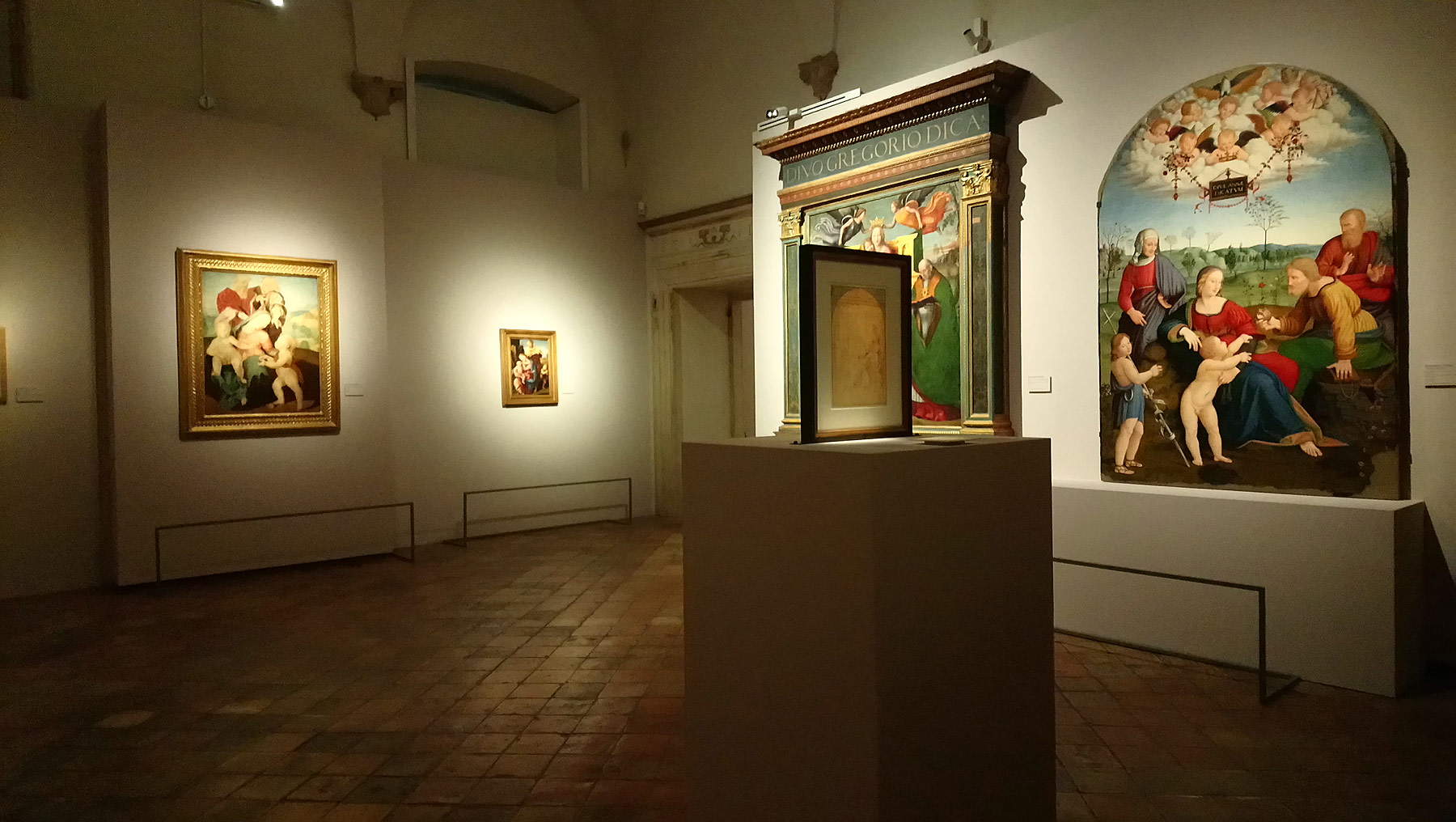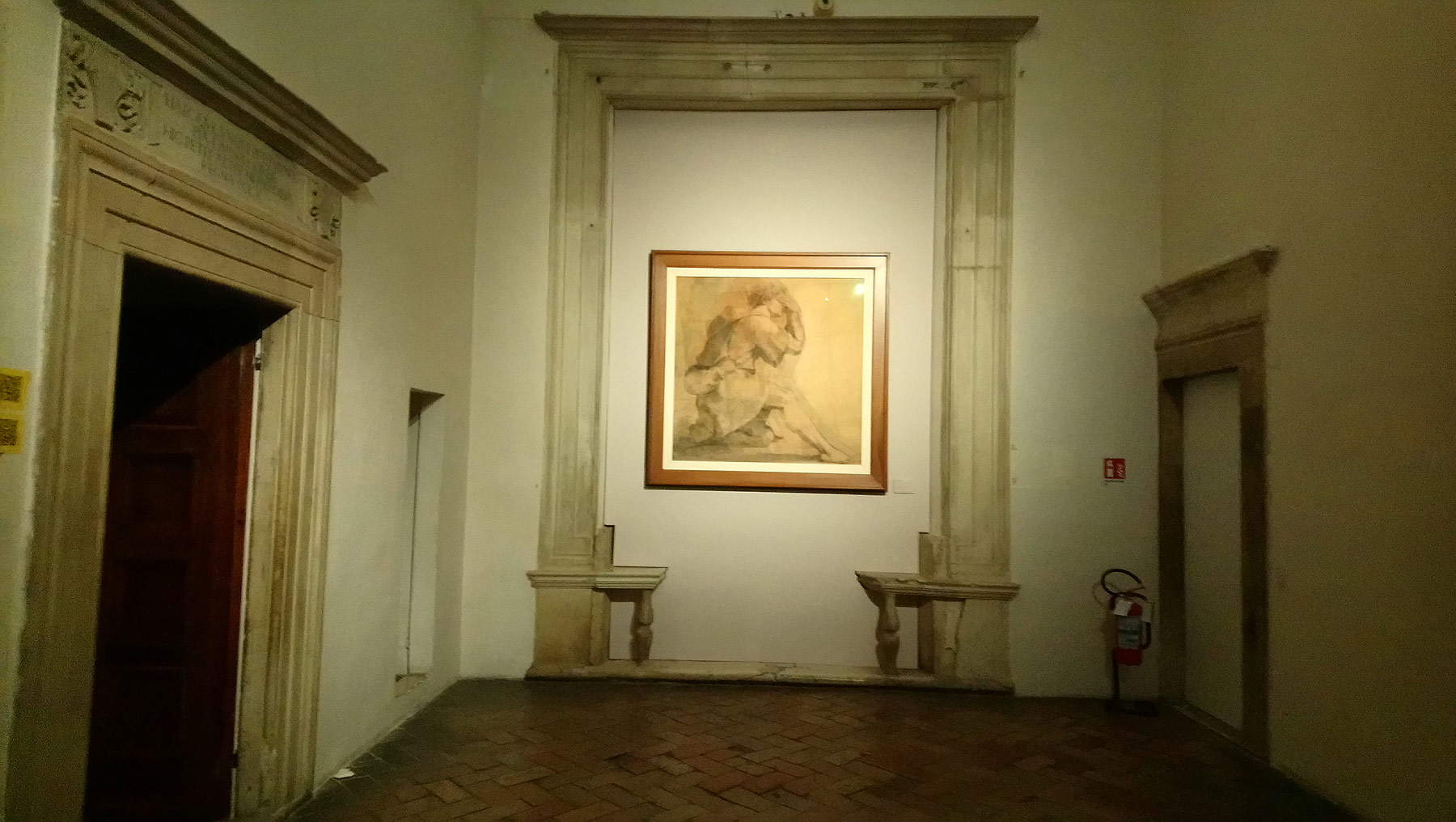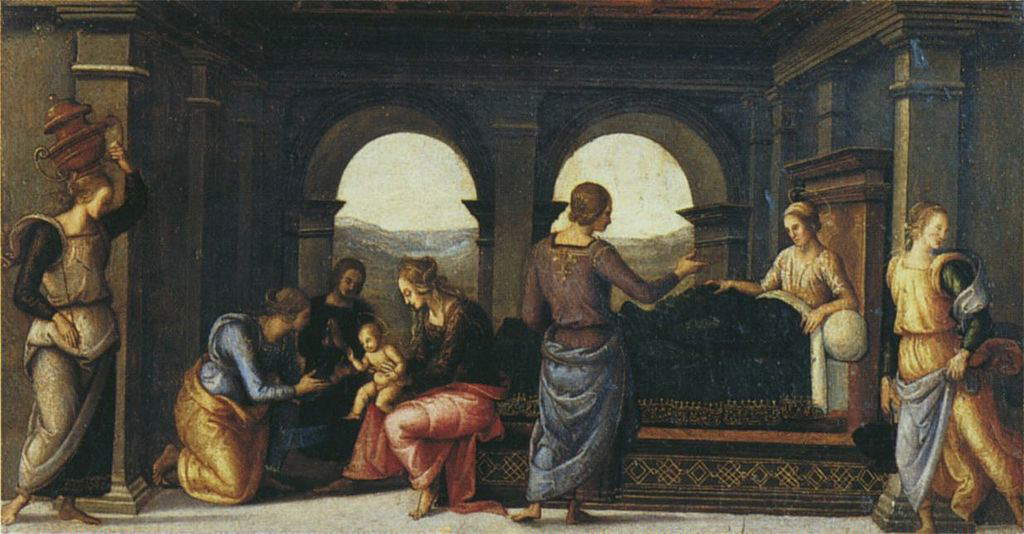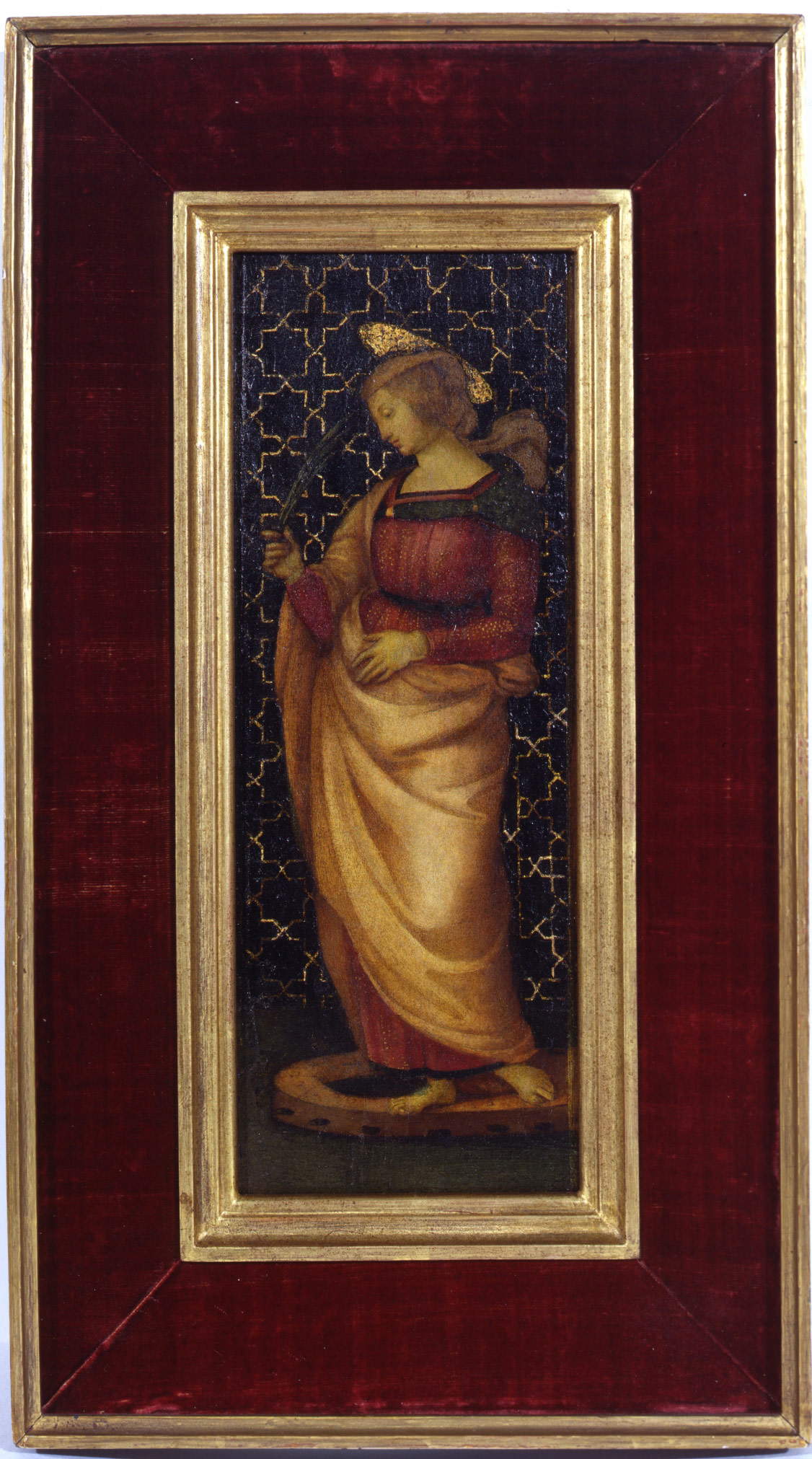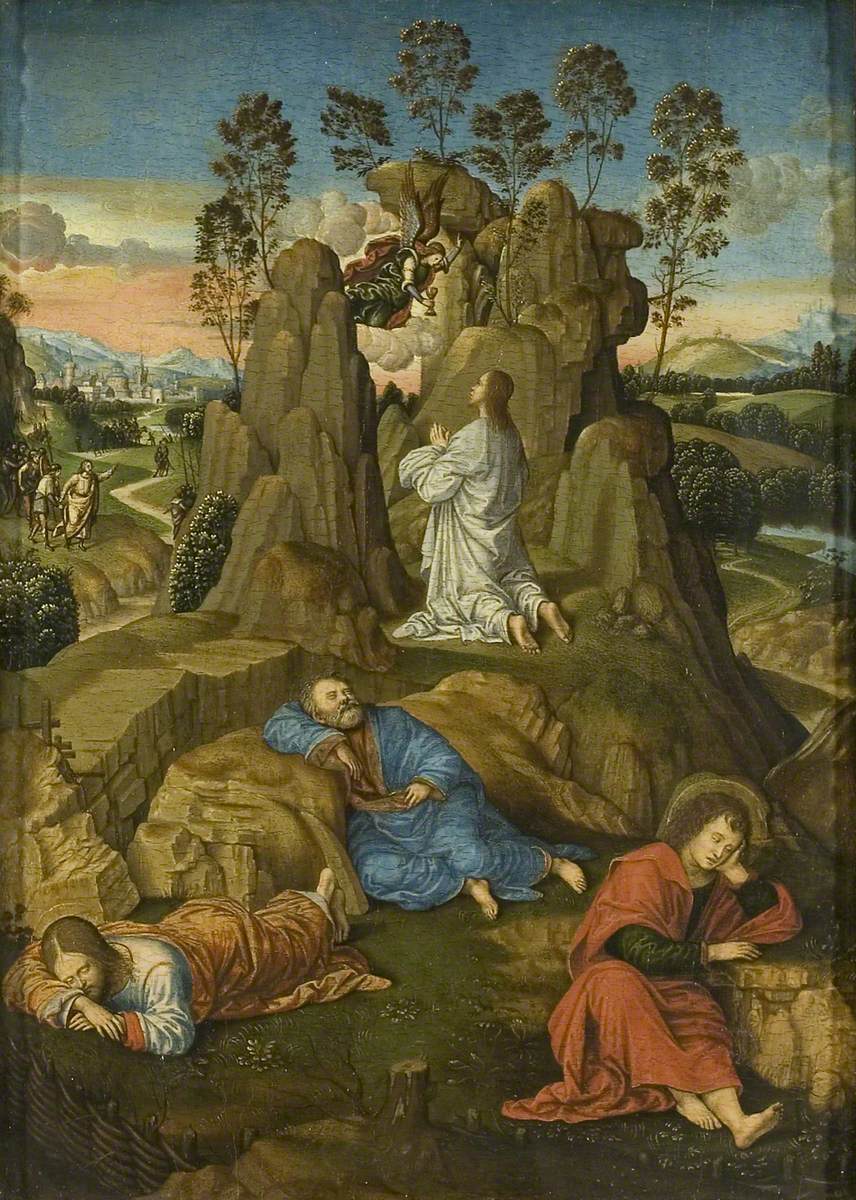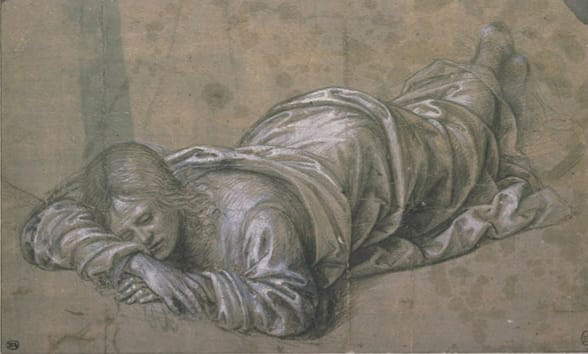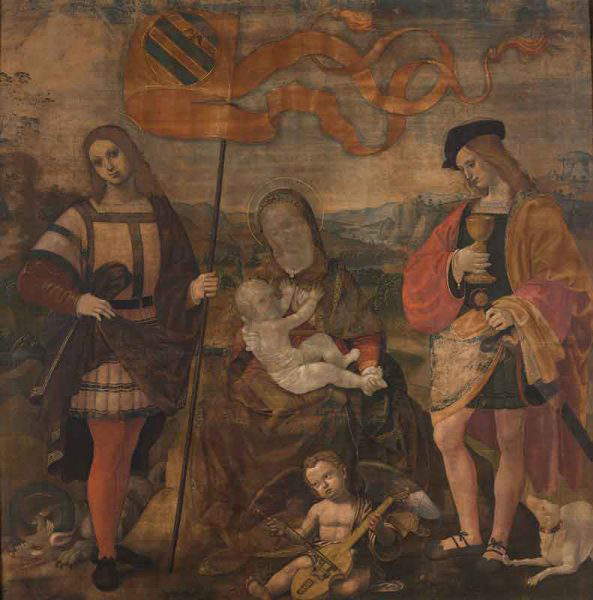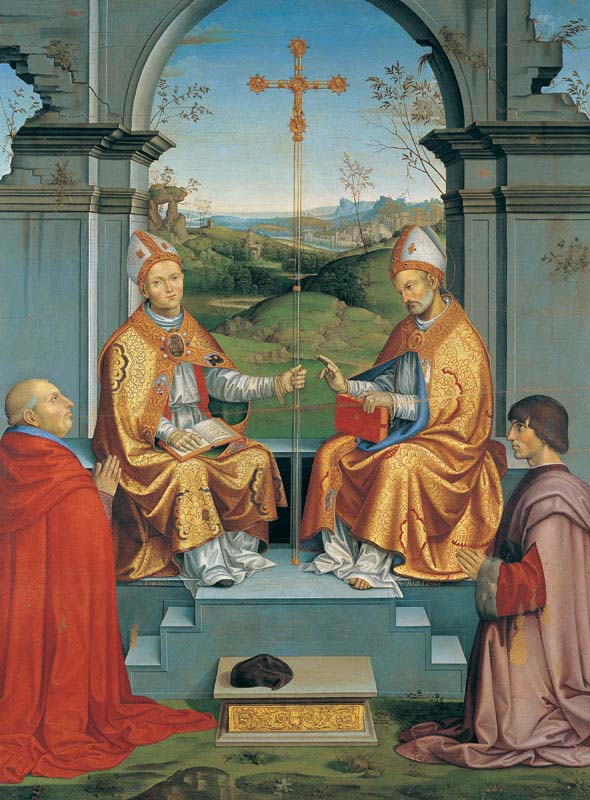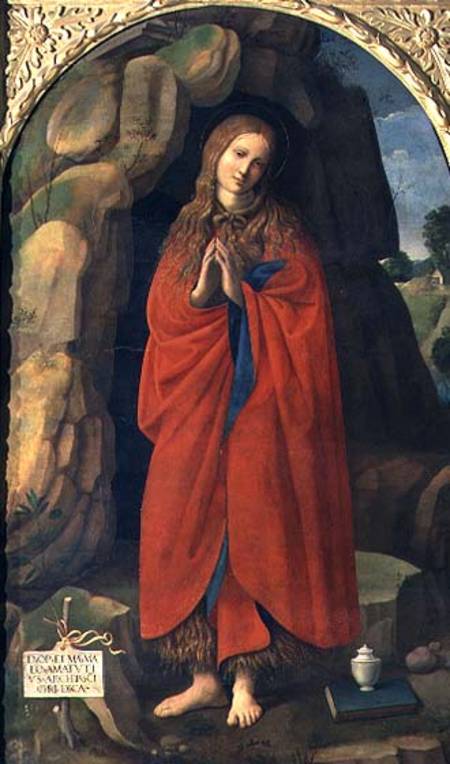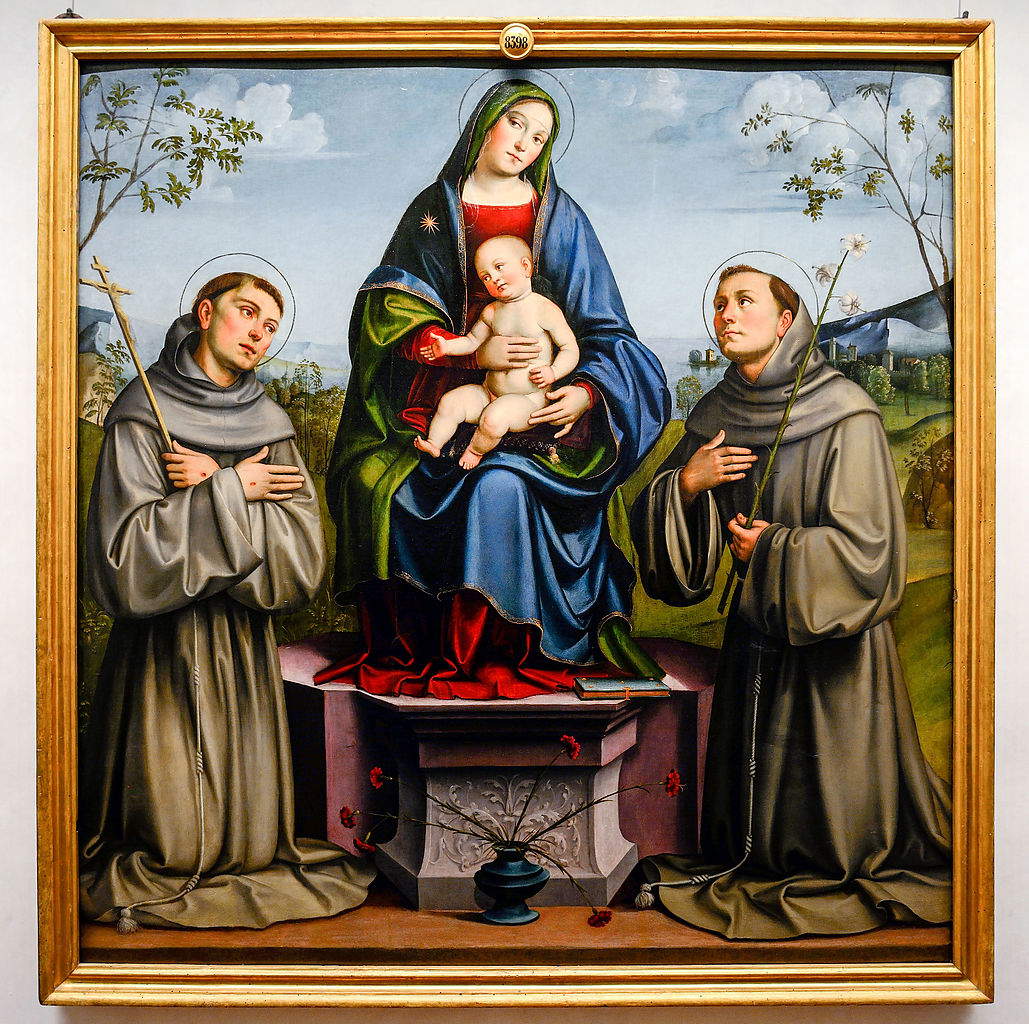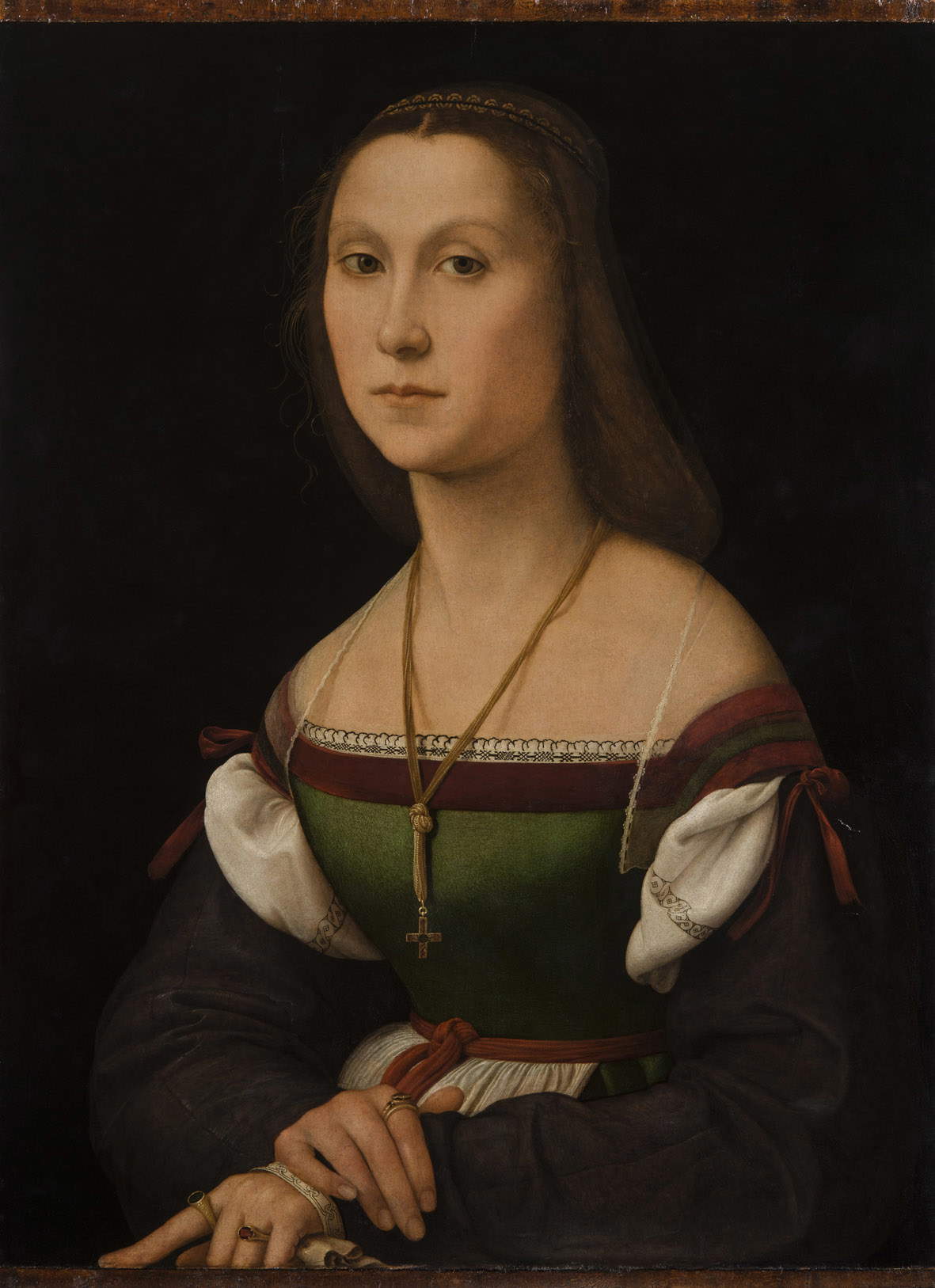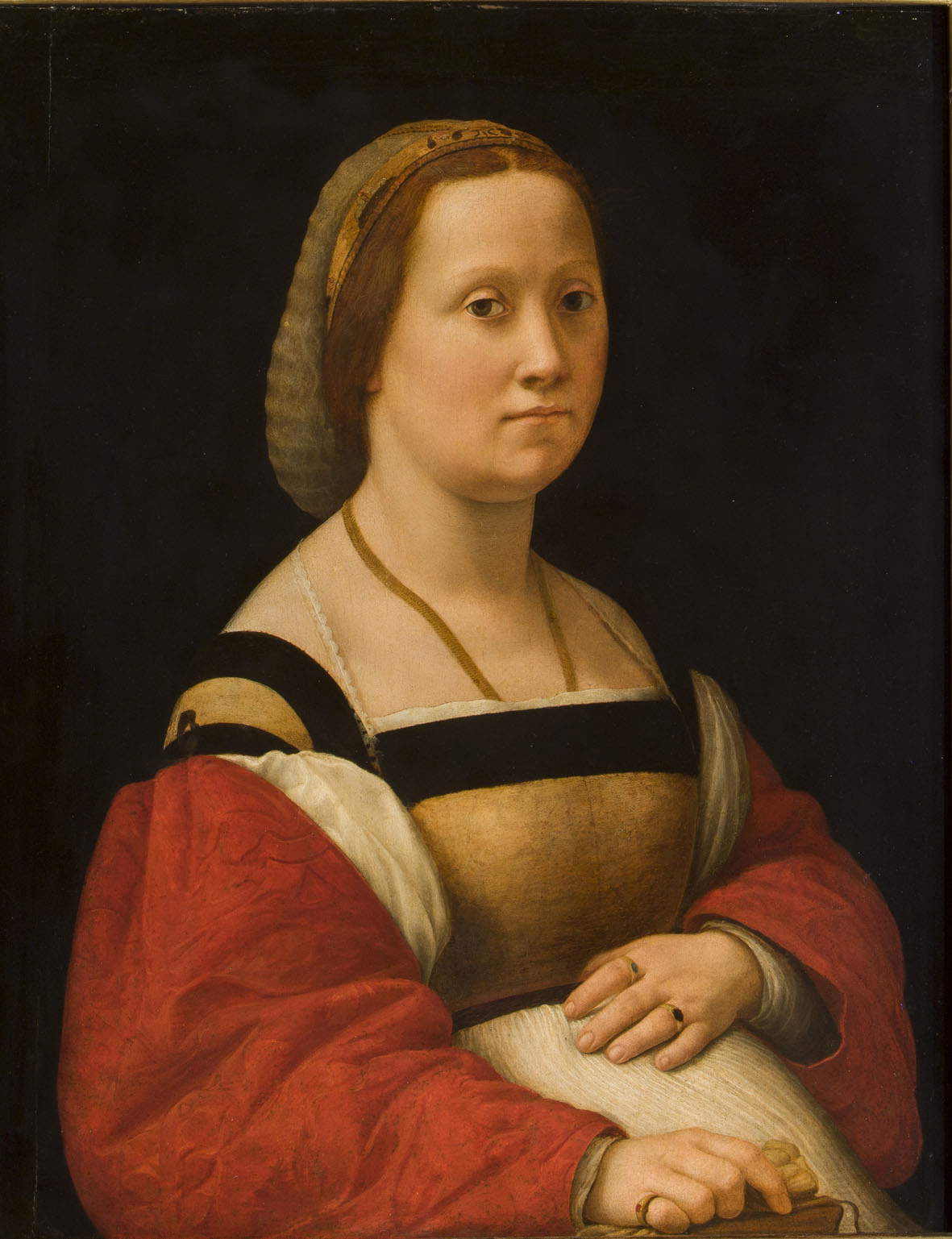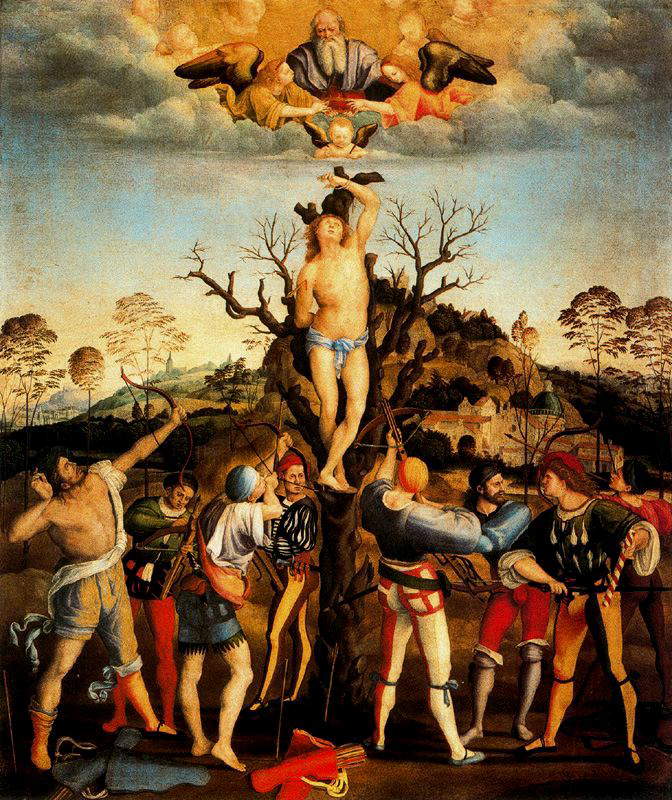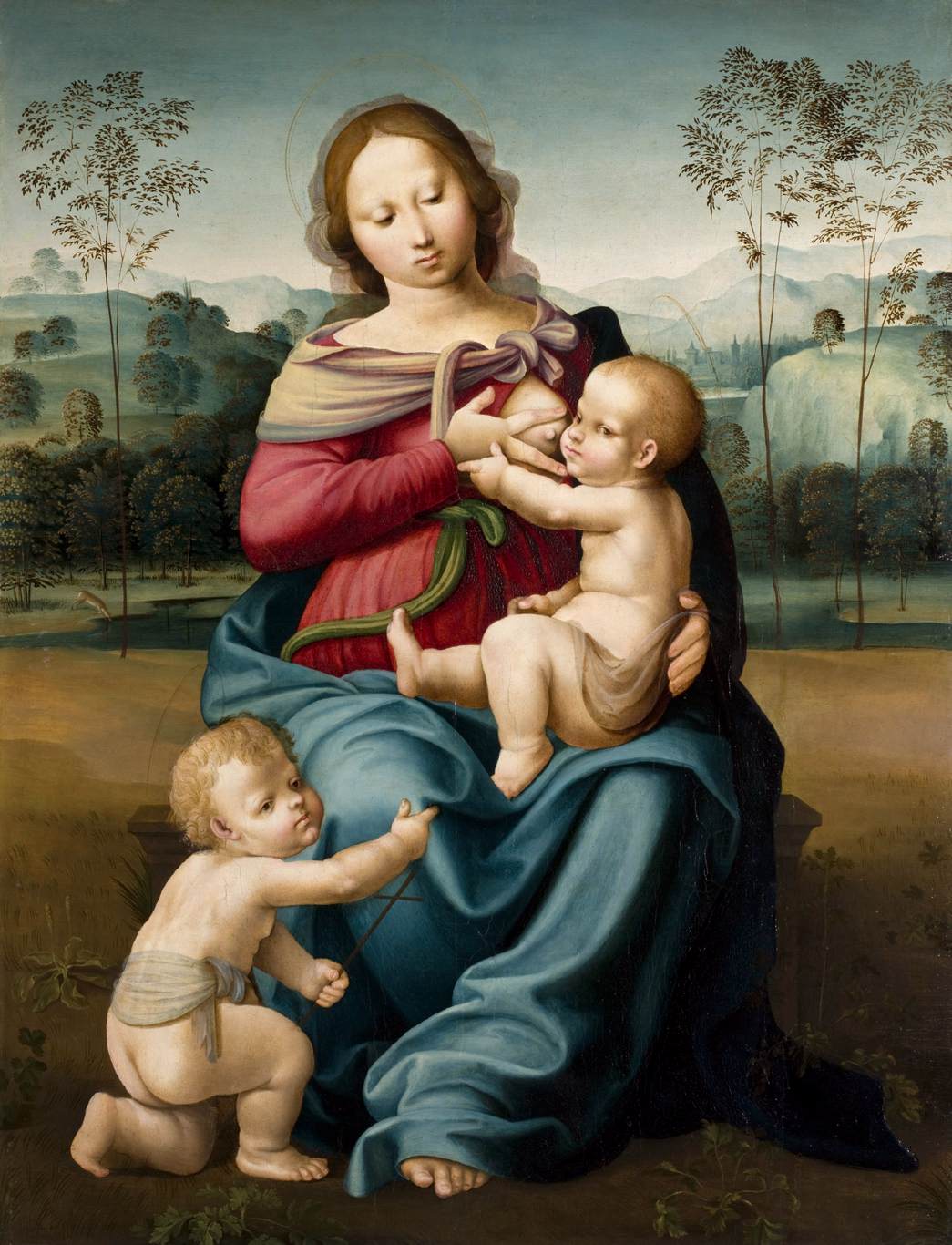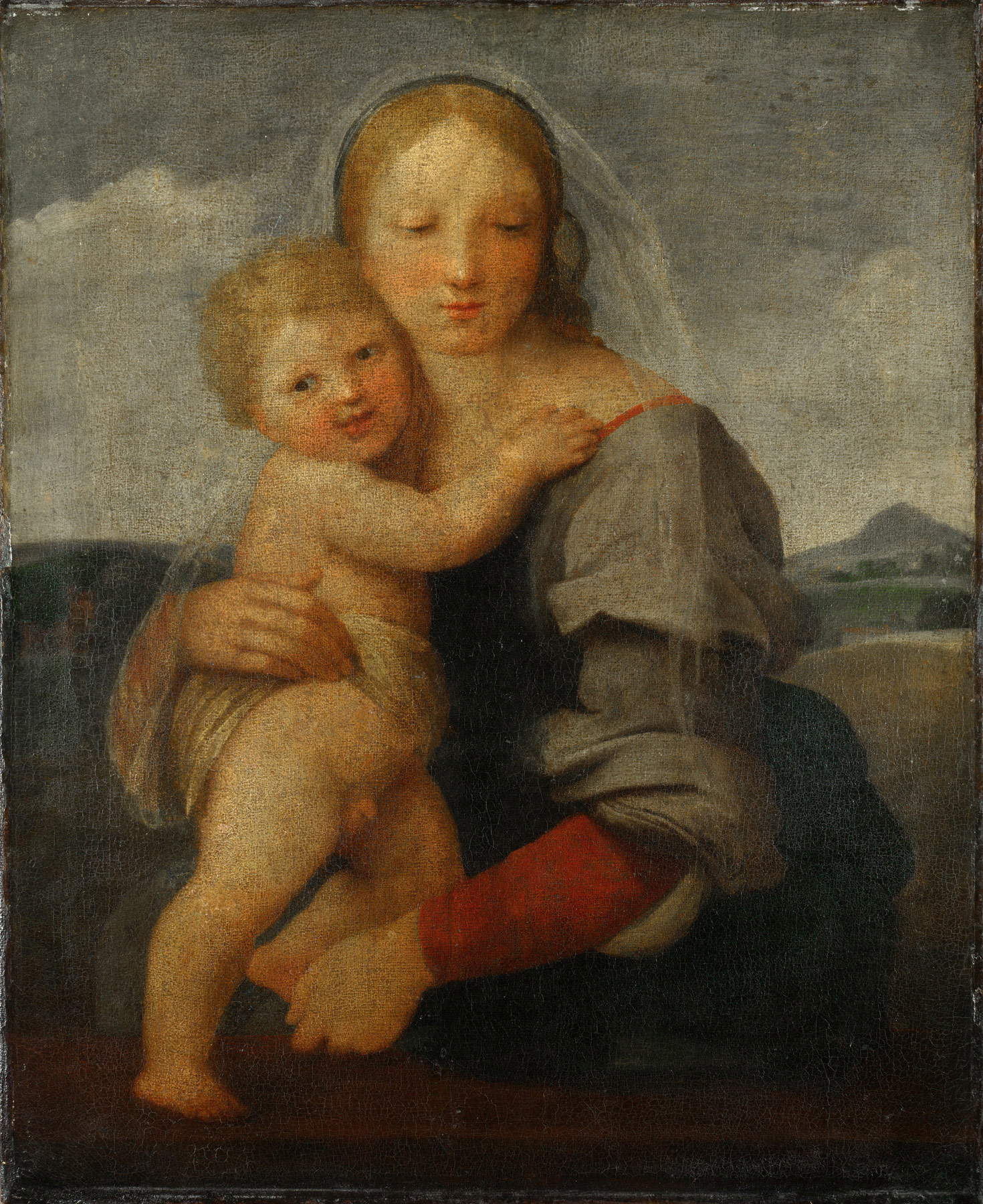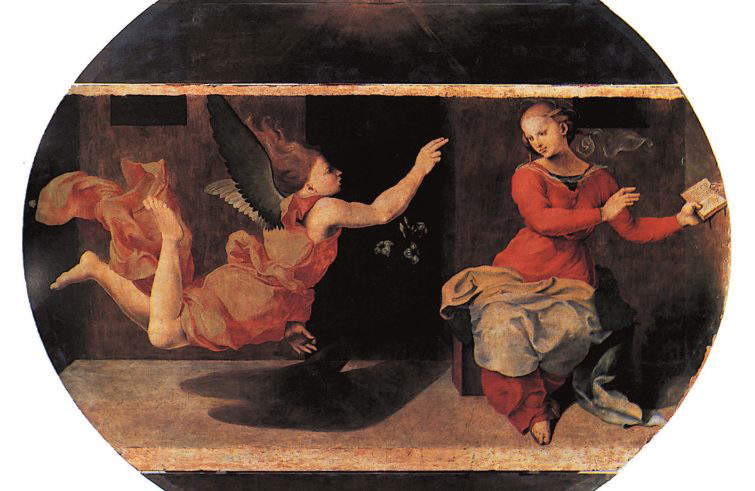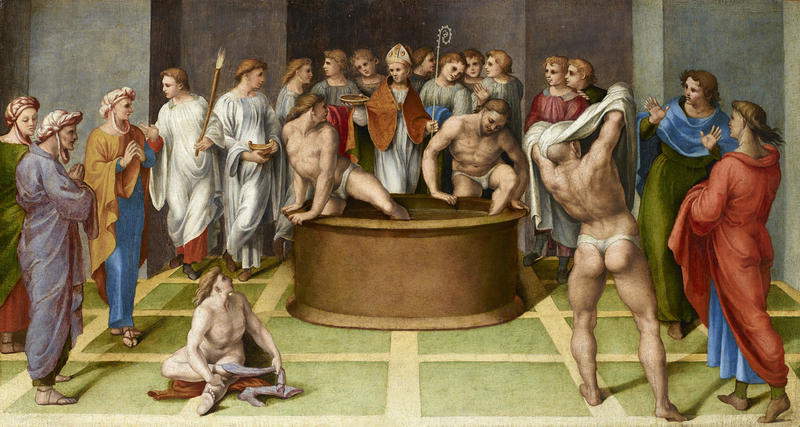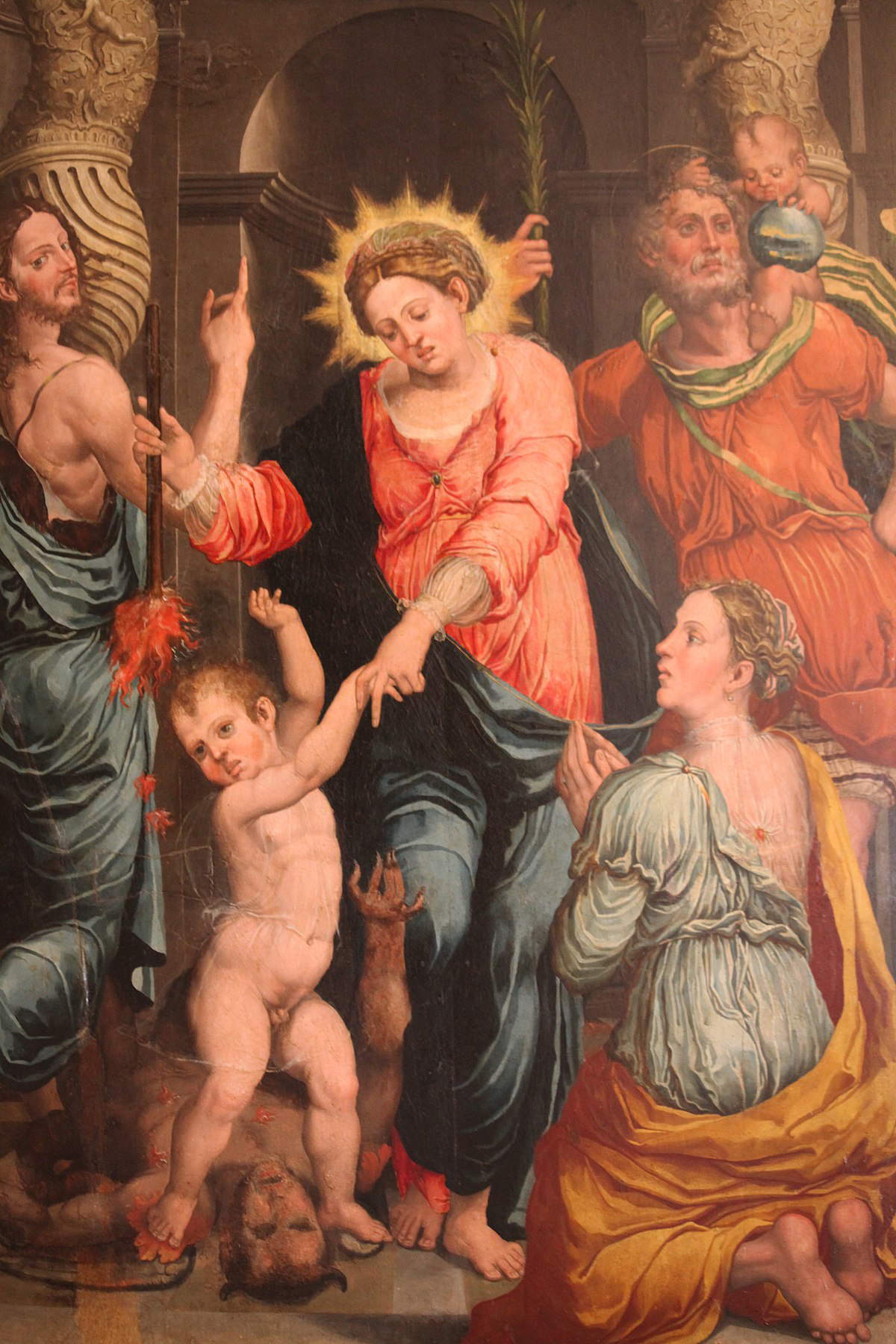by Federico Giannini (Instagram: @federicogiannini1), published on 10/12/2019
Categories: Exhibition reviews
/ Disclaimer
Review of the exhibition "Raphael and the Friends of Urbino" (in Urbino, Galleria Nazionale delle Marche, October 3, 2019 to January 19, 2020)
As is well known to all those who have approached the figure of Raphael Sanzio (Urbino, 1483 - Rome, 1520), tradition usually divides his brief, dazzling, dense and unrepeatable career into three distinct portions: an early youthful phase, which unfolds between his native Urbino and his activities in Umbria in Città di Castello and Perugia, is followed by the four intense Florentine years (from 1504 to 1508), ending with the eleven spent in papal Rome. Marche and Umbria, Florence, Rome: in his wanderings among the most up-to-date artistic centers of central Italy, the young Urbino would never cease to look around, to continue to respond with flair and enthusiasm to whatever cues he was able to derive from observing the results of his colleagues working in those cities, to be constantly open to the new, in a sort of continuous formative journey. But it was an itinerary sui generis, for while Raphael continued to feed on everything he saw, his art emerged increasingly graceful, stunning, original, and capable, according to Vasari, of overcoming nature. Then add a further, singular aspect: wherever he left evidence of his art, Raphael aroused the interest of hosts of other artists, many of them even more mature than himself. And it sometimes happened that while he looked he was in turn looked at.
These complicated entanglements form the basis of the exhibition Raphael and the Friends of Urbino (Urbino, Galleria Nazionale delle Marche, through January 19, 2020), curated by Barbara Agosti and Silvia Ginzburg, and which runs on a double thread: one, the shorter one, presents Raphael’s youthful activity (although it trespasses almost immediately, that is, from the second room, into the Florentine period) while taking care to provide a context (in the first section, perhaps the most challenging, where an attempt is made to reconstruct the artistic situation of Urbino at the end of the 15th century), while the other, the one that most and best supports the layout of the exhibition, is aimed at investigating the journeys of two Urbino artists, Timoteo Viti (Urbino, 1469 - 1523) and Girolamo Genga (Urbino, 1476 - 1551), both a few years older than Raphael but at work in the same years and often in the same places. And, in the exhibition, the presence of Viti and Genga, the former almost always reluctant to embrace the innovations that the younger painter continued to introduce throughout his career and the latter far more inclined, is so substantial that they rise to the true protagonists of the show (by Genga, in particular, a massive body of paintings and drawings is gathered). The result is an exhibition that is neither a monograph on Raphael nor on the two illustrious fellow citizens: it is, if anything, a complex and good focus on their relationship.
Serving as prologue is the theme ofRaphael’s education, and it is in that capacity that, in the first room, works by Perugino, Pinturicchio, and Luca Signorelli alternate: this is not, however, a concession to the public (it should be emphasized that the thread that the two curators have imagined for the first of the six sections into which the exhibition is divided is of strong impact, although not as much as that which one encounters in the room where Raphael’s masterpieces are collected), but of a crucial link, for two reasons. First, because it is necessary to understand the diffusion of Raphael’s genius: in outlining the scientific project of the exhibition, Agosti and Ginzburg thus implicitly suggest that the relations between Raffaello, Viti and Genga should be read from the point of view of the former, that is, according to the ways in which the results of his activity reached the two colleagues, rather than on the paths that Genga and Viti followed in order to welcome Raphael’s innovations (and it is perhaps in this sense that the scarce presence of works by Signorelli in the exhibition should be interpreted: Signorelli, in fact, was Genga’s teacher and was a fundamental artist in his education). Secondly, because thehumus on which Raphael’s genius germinated was to some extent the same humus on which Viti and Genga were formed. What, if anything, distinguished Raffaello from the others, Ginzburg points out, was his way of relating to external stimuli: “Raffaello,” writes the scholar, “developed different manners, the result of the autonomous reworking of the multiple models that alive via he chose and accorded in unprecedented solutions, according to a way of proceeding that [...] with Vasari would be erected as an emblem of the culture of sixteenth-century Mannerism.” A continuous opening up and elaboration to initiate unprecedented research: an approach advocated by humanistic culture, as Ginzburg herself recalls, according to ideas that leveraged the “turning to multiplicity” and the rejection of the single model, and that circulated at the court of Urbino through Florentine humanism.
 |
| Hall of the exhibition Raphael and the Friends of Urbino |
 |
| Hall of the exhibition Raphael and the Friends of Urbino |
 |
| Hall of the exhibition Raphael and the Friends of Urbino |
 |
| Hall of the exhibition Raphael andthe Friends of Urbino. |
Opening the exhibition is precisely Luca Signorelli (Cortona, c. 1450 - 1523), present only with the banner of the Crucifixion, preserved in the collections of the Galleria Nazionale delle Marche and therefore, on the occasion of the exhibition, simply moved to the first floor. It is an Urbino work from the 1590s and therefore pertinent to the opening of the exhibition, since it was a fundamental text for the young Raphael, who would remember it in the Crucifixion Mond, a painting now at the National Gallery in London (not in the exhibition), which not only looks to Signorelli, but is also filled with Perugian elements. Another punctual presence is Perugino ’s Fano predella (Pietro Vannucci; Città della Pieve, c. 1448 - Fontignano, 1523): punctual but also jarring, since the predella was temporarily separated from the rest of the altarpiece that Perugino, between 1488 (the year of his engagement by the Franciscans of Fano) and 1497 (the year of its completion), painted for the church of Santa Maria Nuova, where it still stands today. Much has been written about the relationship between Raphael and Perugino, especially starting with Giorgio Vasari ’s report that he wanted to suggest the presence of the hand of the young Urbino in the paintings of the more mature Umbrian: the exhibition, through the contribution of Anna Maria Ambrosini Massari, retraces the debate originated by Vasari (with, on the one hand, those who stuck to the positions of the Aretine historiographer, and on the other hand those who, on the other hand, recognizing a more marked adherence to Perugino’s manner in the three-year period from 1502 to 1504, believes that it was the master who updated himself on his pupil) to the point of supporting Roberto Longhi’s hypothesis that the first intermediary between Raphael and Perugino was Raphael’s father, Giovanni Santi (Colbordolo, 1440 - Urbino, 1494). The meeting with the master from Città della Pieve would thus have been mediated by his father’s workshop: evidence of this would be the so-called Natività di Casa Santi, the fresco that decorates one of the walls of the artist’s birthplace in Urbino and which finds perfect correspondence in the figure of the nurse who appears in the scene of the Nativity of the Virgin in the Fano predella. Rounding out the rapid cadre of references is Pinturicchio (Bernardino di Betto; Perugia, c. 1454 - Siena, 1513), present with a couple of works including a masterpiece such as the Madonna of Peace from the late 1580s, which came on loan from the Pinacoteca Comunale di San Severino Marche to underscore how its author is to be included among the young Raphael’s cultural references: it is well known how the two, in Siena, collaborated, and in the context of the Galleria Nazionale delle Marche’s exhibition, the Madonna della Pace is functional above all to remind us of this closeness, rather than to provide exact matches that would, if anything, have to be found in works not in the exhibition (or, if one really wants to find them, there will be to look at the Madonna’s features and attitude).
The three protagonists of the exhibition arrive in quick succession: Raphael’s St. Catherine of Alexandria, the first work by the Urbino artist to be encountered, dating perhaps from the early 16th century (and with a troubled attributional history), is perhaps as close to Pinturicchio as can be found along the way (“conspicuous in this very small-scale proof,” writes Valentina Catalucci in the catalog, "the search for a precious and pungent painting, still perceptible in the dabs of golden light that make the saint’s red dress stand out alongside the warm tone of her cloak, in the psrezzatura with which the young woman holds the palm of martyrdom, in the imitation on the verso of the polychromy of marble." characters that refer to the lesson of Pinturicchio before that of Perugino prevailed). Not far away is observed a Beato Bernardino da Feltre presented with an attribution to Girolamo Genga relaunched for the occasion by Ambrosini Massari: the panel, also from the early 16th century, is traced back to a Pinturicchio origin that the scholar identifies as the ground that unites Genga and the Raphael of the Caterina d’Alessandria. What divides Genga from Raphael, however, is the more stringent dependence on Signorelli that is substantiated in the saint’s obvious expressionist features. The long chapter on Timoteo Viti opens instead with theOration in the Garden flanked by the study for the figure of the sleeping St. James that can be seen in the lower register of the finished composition. The panel, arriving from Bristol, is believed to be Viti’s earliest known work, and is placed in the 1890s, when the artist was in Bologna in the workshop of Francesco Francia (Francesco Raibolini; Bologna, c. 1450 - 1517), a refined master of the Felsine Renaissance, who is present in the exhibition with a conspicuous selection. Viti, though from Urbino, looked mainly to the culture of Emilia (Bologna and Ferrara): the same was true of one of his works probably made after 1501, the Madonna and Child with Saints Crescentino and Donnino, finished by 1503, soon after his return to Urbino. In the meantime, Viti had made time to study, in advance of Raphael who was to absorb it in Florence, Leonardo’s lesson: for Viti, however, it was above all a formal reworking, evident here especially in the posture of the Madonna. The persistence of the Raibolinesque models in Viti’s works even after his return to Urbino (and, therefore, his initial reluctance to other solicitations) is evidenced by a couple of works such as the Arrivabene Altarpiece of 1504, exemplified on the highest texts of Francia (look at the ruins in the background) and the very sweet Saint Mary Magdalene, among the peaks of the Marche painter’s production. Instead, there are five works by Francia on display: above all, the Madonna and Child Enthroned and Saints Francis and Anthony of Padua marks one of the greatest tangencies with the art of Perugino, who along with Francia was seen by Vasari as a key artist in the transition to the mature Renaissance. Thus in part explains the perhaps all too copious presence of Raibolini in the exhibition, beyond the significant role he played in Viti’s education: on the importance of the Bolognese environment in this transition, Daniele Benati’s essay in the catalog is noteworthy.
 |
| Luca Signorelli, Crucifixion (1494; oil on canvas, 156 x 104 cm; Urbino, Galleria Nazionale delle Marche) |
 |
| Perugino, Nativity of the Virgin, from the predella of the Fano altarpiece (1488-1497; oil on panel, 25 x 50 cm; Fano, Santa Maria Nuova) |
 |
| Pinturicchio, Madonna of Peace (c. 1488-1490; tempera on panel, 94 x 64 cm; San Severino Marche, Pinacoteca Comunale Tacchi Venturi) |
 |
| Raphael, Saint Catherine of Alexandria (1502-1503; tempera and oil on panel, 39 x 15 cm; Urbino, Galleria Nazionale delle Marche) |
 |
| Timoteo Viti, Oration in the Garden (1490-1495; tempera on panel, 31.1 x 21.9 cm; Bristol, Bristol City Museum and Art Gallery) |
 |
| Timoteo Viti, Study for Sleeping Saint James (1490-1495; charcoal, pen and gray ink, white lead on gray-green prepared paper, 145 x 240 mm; Paris, Louvre, Département des Arts graphiques) |
 |
| Timoteo Viti, Madonna and Child with Saints Crescentino and Donnino (c. 1501-1503; tempera on canvas, 167.1 x 167.4 cm; Milan, Pinacoteca di Brera) |
 |
| Timoteo Viti, Saints Thomas Becket and Martin of Tours adored by Bishop Giovan Pietro Arrivabene and his nephew Giacomo (Arrivabene Altarpiece) (1504; oil on panel, 204 x 156.5 cm; Urbino, Galleria Nazionale delle Marche) |
 |
| Timoteo Viti, Saint Mary Magdalene (1508; tempera on panel, 191 x 116 cm; Urbino, Galleria Nazionale delle Marche) |
 |
| Francesco Francia, Madonna and Child Enthroned between St. Francis and St. Anthony of Padua (c. 1500; oil on panel, 135 x 140 cm; Florence, Uffizi Galleries, Depots) |
The moment most awaited by visitors comes in the second room, where the encounter between Raphael, Genga and Viti is closely investigated and, above all, where some of Raphael’s best-known works follow one another: introducing the sequence, is a comparison of those in the style of the manuals (and already proposed elsewhere in the past) between Perugino’s splendid Saint Mary Magdalene, housed in the Galleria Palatina in Palazzo Pitti, and Raphael’s Saint Sebastian, which again comes out of the Accademia Carrara in Bergamo. The shape of the features, the gaze, and the cultural references that hark back to the Flemish world (on such examples, Memling in the lead, Perugino imagined his Magdalene, so much so that it often led critics, and the Urbino exhibition is no exception, to speculate that the painting actually conceals a portrait in the guise of the penitent saint) are the features that bring the two works closer together. There is also something new for Perugino’s Magdalene, as Silvia Ginzburg launches the idea of reconsidering the attribution to the Umbrian artist: the art historian points out that, while there are insufficient reasons to subtract from it, “the effigy of courtly taste, evoking a widow perhaps named Magdalene, appears typified according to the formula of the sacred painter Perugino, to the point that one would be tempted to say it was painted ’à la manière de’, not by Vannucci himself, but by one of his most intelligent imitators.” The always happy juxtaposition of the two works is followed by a theory of Raphael’s works that fulfills the expectations of many: La Muta arrives, a work whose origin was hypothesized in the context of the Feltresque commission but which may have originated in Florence, La Gravida, in all probability to be traced back to the same cultural matrix as the painting that precedes it, and again the Madonna Conestabile, among the first Florentine tests of a Raphael then 21 years old or little older as well as among Raphael’s earliest reflections on the works of Leonardo da Vinci (Vinci, 1452 - Amboise, 1519). The Child’s attitude, and in part that of the Madonna, hark back to the unfinishedAdoration of the Magi, now in the Uffizi.
However, rather than focusing on Raphael, the Urbino exhibition is here aimed at deploying the wide range of references to which Genga had occasion to refer during his Florentine sojourns, even though his beginnings in the Tuscan city were spent in the sign of his earlier experiences, as attested by the Martyrdom of Saint Sebastian, on loan from the Uffizi, still heavily dependent on Luca Signorelli, but nonetheless already filtering Florentine models (starting with Piero del Pollaiolo, whose ascendancy is most evident in the figure of Saint Sebastian tied to the bare trunk). Soon, however, Genga would go beyond the legacies of the past to embark on a close reflection on Raphael’s art, as shown in the Madonna and Child with St. John of Siena’s Pinacoteca Nazionale, one of the first works to open up to Raphael’s grace, or the counterpart panel in the Alana Collection, where the artist rereads Raphael in the light of other cues, starting with the Nordic and Domenico Beccafumi (Montaperti, 1486 - Siena, 1551): a fascinating Madonna and Child with St. John the Baptist, from the Orintia Carletti Bonucci Foundation, is exhibited by the latter, presented as itself an original rereading of Raphael’s Madonnas but also to reveal Genga’s “leading role on future directions” (so Emanuele Zappasodi in the catalog entry). Returning to the Madonna in the Alana Collection, it is worth noting that in this panel, writes Barbara Agosti, the artist "arrives at fantastically expanded forms, with unnaturally dilated volumes, with a turned three-dimensionality, as in the Madonna’s ovoid head grafted onto the cylindrical shaft of the neck, with soft shadows shaping the bodies and a refined range of colors and transparencies: thus not a Genga who limits himself to slavish imitation, but an artist who gives rise to experiments that already foreshadow Mannerist horizons. The intermediate step between Urbino’s experiences and the revisiting of Raphael’s modes is identified by the curators in a tondo, also from the Pinacoteca Nazionale in Siena, depicting the Madonna and Child, St. John and St. Anthony of Padua, produced at the time when Genga was staying in Siena (between 1510 and 1512) to attend to the fresco decorations of Pandolfo Petrucci’s residence. Finally, a study of a kneeling Magdalene by Timoteo Viti concludes the room to document the moment of greatest proximity between its author and Raphael. The two worked together on the site of Santa Maria della Pace in Rome: yet Viti, for almost his entire career, would show resistance to the younger colleague’s research.
 |
| Perugino, Saint Mary Magdalene (c. 1500; oil on panel; 47 x 35 cm; Florence, Palatine Gallery, Palazzo Pitti) |
 |
| Raphael, Saint Sebastian (1501-1503; mixed media on panel, 45.1 x 36.5 cm; Bergamo, Accademia Carrara) |
 |
| Raphael, La Muta (1507; oil on panel, 65.2 x 48 cm; Urbino, Galleria Nazionale delle Marche) |
 |
| Raphael, La Gravida (1505-1506; oil on panel, 66.8 x 52.7 cm; Florence, Galleria Palatina, Palazzo Pitti) |
 |
| Girolamo Genga, Martyrdom of Saint Sebastian (c. 1505-1510; oil on panel, 100 x 83 cm; Florence, Galleria Palatina di Palazzo Pitti) |
 |
| Girolamo Genga, Madonna and Child with St. John the Baptist (c. 1511-1513; oil on panel, 94.6 x 72.8 cm; Newark, Alana Collection) |
 |
| Domenico Beccafumi, Madonna and Child with St. Giovannino (1510-1512; oil on panel transported on canvas, 65 x 59 cm; Perugia, Fondazione Orintia Carletti Bonucci) |
 |
| Girolamo Genga, Madonna and Child with St . John and St. Anthony of Padua (c. 1510; oil on panel, diameter 103 cm; Siena, Pinacoteca Nazionale) |
The third room represents a kind of coda to what was collected in the previous section: the comparison between the Mackintosh Madonna and its cartoon is one of the high points of the exhibition, not only because it offers the opportunity to see the splendid Madonna and Child (the latter is one of the tenderest of Raphael’s production), now at the National Gallery in London, paired with the idea from which it was generated, but also in that it gives insight into how Raphael’s inventions spread. The comparison is thus with a Madonna and Child between Saints Gregory and Nicholas of Bari by Domenico Alfani (Perugia, c. 1480 - 1553), where the Madonna protagonist of the composition is an exact take on the Mackintosh Madonna (and Alfani, a painter very close to Raphael, would later further contribute to his fortune in the Umbrian-Marchigiano context). Returning to Genga, still fully Raphaelesque is the cartoon (the only large one of his that has come down to us, at half a meter in height: however, the eventual painted translation has not reached us) for a Madonna and Child and St. John with an unusual iconography (St. John is caught in the act of kissing one of the Child’s feet). This moment in the itinerary is also distinguished by the irruption of theMichelangelesque element, both in Raphael (the Madonna Aldobrandini, for which Ginzburg points out an early response by the artist to the Sistine Chapel vault) and in Genga, who in the Holy Family with St. John from a private collection takes up the structure of Michelangelo’s Tondo Doni.
Having passed a fourth section with a very quick lunge on Roman Raphael, the fifth explores Genga’s Romagna activity: an opportunity to assess the contribution of Fra’ Bart olomeo (Bartolomeo della Porta; Florence, 1472 - Florence, 1517) on the art of the Marche artist. In particular, the analysis is on the figurative sources of one of Genga’s most important paintings, the Dispute of the Doctors, which was commissioned from him on September 12, 1513, for the church of Sant’Agostino in Cesena, finished in 1518, installed in 1520 and then dismembered as a result of Napoleonic spoliations: the altarpiece, which has not been brought to the exhibition (there are, however, the cymatium with theAnnunciation, the only part of the work still in situ, and one of the panels that make up the predella, the one with St. Augustine baptizing the catechumens, preserved at the Accademia Carrara in Bergamo), is evoked by some drawings related to it, placed in comparison with the folios by Fra Bartolomeo. More specifically, the dependence of Genga’s altarpiece on Raphael’s Madonna del Baldacchino and on Fra’ Bartolomeo’s Pala del Gran Consiglio is emphasized: three sheets (a compositional study, a study for a Madonna and Child and a study for several figures) are linked to the latter, testifying to the genesis of the work as well as to its affinities with Genga’s. The tour concludes with an overview of the relations between Raphael, Genga and other important “heirs” following the Urbino’s disappearance in Rome in 1520: Genga’s Resurrection preserved at the Oratory of Santa Caterina in Via Giulia in Rome (a study for the figure of the risen Christ is in the exhibition) is a meditation on Raphael’s Transfiguration, and inspired by Roman models is also the Mystical Marriage of St. Catherine of Alexandria in the presence of St. Catherine of Siena and St. Bernardine (“the choice to frame the event in a domestic context permeated by indirect luminosity,” writes Alessandra Caffio, "finds the most elouent comparisons in some of Giulio Romano’s works, such as the Hertz Madonna or the Madonna della Gatta in the Capodimonte Museum in Naples&rdquo). Testifying to the activity of Giulio Romano (Giulio Pippi de’ Iannuzzi; Rome, c. 1499 - Mantua, 1546), a continuator of Raphael’s workshop, is the cartoon for the Stoning of St. Stephen, the altarpiece for the church of Santo Stefano in Genoa: the presence of the cartoon in the exhibition is motivated by Barbara Agosti on the basis that the work represents “the developments of Raphael’s last lesson intercepted in Rome by Girolamo Genga after his stay in Romagna and by the younger Raffaellino del Colle during his discipleship at Giulio’s, which in all probability began between the end of 1519 and the following year.” It is precisely with Raffaellino del Colle (Sansepolcro, 1495 - 1566), who was a pupil of Giulio Romano as well as one of Genga’s main collaborators, that the review ends: the Madonna and Child with St. John is steeped in Giulio Romano’s lesson but dilutes the master’s manner in a more marked formal simplification; the altarpiece for the parish church of Lamoli (reassembled for the first time on this occasion) is there to give an account of how Raphael spread Raphael’s language to the Marche region, while the Madonna del soccorso, the third and last of his works in the exhibition, is a work mindful of Roman Raphael but updated on Giulio Romano’s Mantuan solutions (the twisted columns so dear to the master are present to frame the scene).
 |
| Raphael, Mackintosh Madonna (c. 1508-1510; oil on panel transported on canvas, 78.8 x 64.2 cm; London, National Gallery) |
 |
| Raphael, Cartoon for the Mackintosh Madonna (c. 1508-1510; black pencil and/or charcoal, white chalk, openwork and partially incised outlines on two joined sheets, 707 x 533 mm; London, British Museum) |
 |
| Raphael, Madonna Aldobrandini (1512; oil on panel, 38.9 x 32.9 cm; London, National Gallery) |
 |
| Girolamo Genga, Annunciation (1516-1518; oil on panel, 133 x 245 cm; Cesena, Sant’Agostino) |
 |
| Girolamo Genga, Saint Augustine Baptizing the Catechumens (1516-1518; oil on panel, 49.5 x 91.7 cm; Bergamo, Accademia Carrara) |
 |
| Raffaellino del Colle, Madonna and Child with St. John the Baptist (c. 1525; oil on panel, 129 x 106 cm; Rome, Galleria Borghese) |
 |
| Raffaellino del Colle, Madonna del Soccorso tra san Giovanni Battista e san Cristoforo (c. 1536; oil on panel, 223 x 145 cm; Urbino, Galleria Nazionale delle Marche) |
Among the merits of Raphael and friends in Urbino is certainly the importance accorded to drawings, not least because of the difficulties faced when an exhibition delves into the subject of drawing in the Marche during the Renaissance: a situation in which, Anna Maria Petrioli Tofani notes, who dedicates a special essay to the question in the catalog, “any attempt to recompose a coherent and circumstantial image remains studded more with questions than answers, although there exists on the subject a very vast bibliography in which some of the most illustrious names in artistic historiography have exerted themselves over the last two centuries.” The path is made impassable by the relative scarcity of material that has come down to us (obviously if one places the Marche in comparison with other realities) and by the fact that, in and around Urbino, drawing was not done with the same rigor that animated the exercises of Florentine painters: if in Florence, Petrioli Tofani continues, “drawing traditionally constituted daily exercise of the hand and thought” and “the drawing phase entered directly into the process of germination and refinement of ideas that would be concretized in paintings, sculpture and architecture,” in the Marche, on the contrary, probably little drawing was done and in a non-systematic way, so that the Marchegiani used drawing “in a more episodic way and with more than instrumental purposes.” This is an idea that the exhibition intends to bring out through the selection of folios that follow one another throughout its rooms.
In setting out to celebrate the five-hundredth anniversary of Raphael’s death, the Galleria Nazionale delle Marche has ordered an exhibition not so much on him (not least because the knotting together of the many threads that make up his training and his presence in the Umbrian-Marchigian context of the late fifteenth century is an operation that was beyond the scope of the exhibition’s objectives), but on the interweaving of relations between Raphael, Genga and Viti (although Genga’s presence is much more voluminous than Viti’s, so much so that one can almost read into it a sort of exhibition within the exhibition): an exhibition that is certainly refined, certainly not the easiest for the general public (the very subject matter of the exhibition is hostile, as well as highly and variously articulated, and the risk is that of not fully grasping some passages, especially where the chronology is not made explicit), but also inviting by virtue of its complexity and engaging because of the quality of the selection and loans, the punctuality of the comparisons, and the soundness of the project. If the outcome is perfectible from the point of view of the dialogue with visitors, the Galleria Nazionale delle Marche nevertheless deserves the credit for having seized the anniversary of the coming year without resting on a predictable or repetitive exhibition, but proposing a reading of the context (as well as, of course, of Raphael’s art) according to a perspective that had not been previously screened.
Warning: the translation into English of the original Italian article was created using automatic tools.
We undertake to review all articles, but we do not guarantee the total absence of inaccuracies in the translation due to the program. You can
find the original by clicking on the ITA button. If you find any mistake,please contact us.

